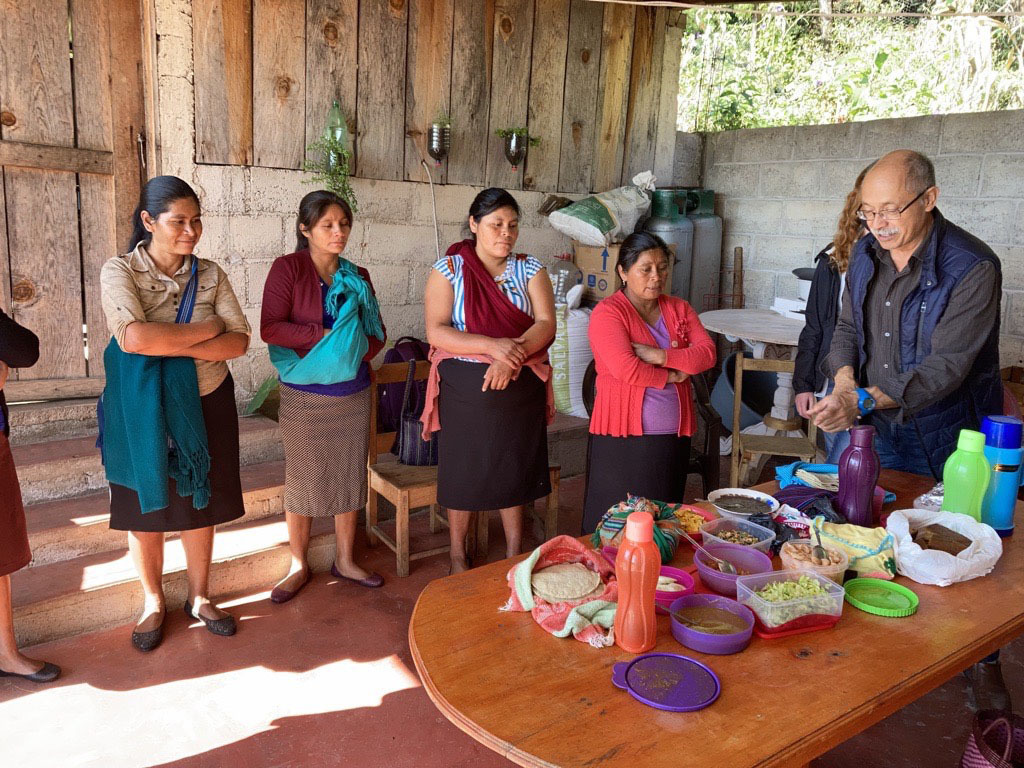Adapting to a changing climate in Southern Mexico

Our hosts set out a feast: fresh tortillas made from hand-milled local corn, beans and tomatillo salsa from backyard gardens, scrambled eggs with tomato and onion. Everything was grown within San José de la Nueva, a rural community in the Mexican state of Chiapas.
Ernesto Gutierrez, pastor and director of the Institute for Intercultural Studies and Research (Instituto de Estudios e Investigación or IESII by its Spanish acronym) invited me and other Mennonite Central Committee (MCC) staff to visit this community to learn about agricultural innovations the community was implementing, including greenhouses, organic fertilizers, and efforts to grow fruits and vegetables year-round.
I had spent the previous two years advocating from my Washington, D.C. home office for support for adaptive agriculture projects like these initiatives supported by MCC. I read about changing weather patterns, but behind a screen it’s difficult to fully appreciate the impact these changes have on a community.
“When we were growing up, we ate naturally,” community member Adelina Velazquez told us, her grandchildren playing at her feet. “Beans, vegetables – we grew everything here.”
“My great grandparents used to know when to plant, but now we aren’t able to respect the traditional timelines.”
A few decades ago, she said, the rain started to become more unpredictable. First, there were the droughts – dry periods of two or three years where crops shriveled on the stalks. Then, rain would fall torrentially out of season, drowning them.
“My great grandparents used to know when to plant, but now we aren’t able to respect the traditional timelines,” Adelina continued, “Everything is harder now.” She shook her head. “How are my children going to live? How are they going to eat?”
Residents of San José de la Nueva are descended from a Mayan people group who have been cultivating the land in Southern Mexico since before the Spanish conquest. Most speak the Mayan language Tzeltal as their first language and Spanish as their second. Ernesto traces some issues of food insecurity back to the time of Spanish rule when indigenous Mexicans were forced away from their communities to work the Spanish colonist’s haciendas. “Before the conquest, the diet here was richer and more nutritionally diverse,” Ernesto tells us.

Ernesto sees IESII’s role not as providing information that communities lack, but as helping communities reclaim knowledge that their ancestors held. His goal for these communities goes beyond food security – having enough to eat – but strives for “food sovereignty” – the right to healthy and culturally appropriate food produced sustainably.
Communities in Chiapas face twin threats to food sovereignty. First, climate change makes weather patterns increasingly unpredictable. Second, large industries pollute and encroach on community land. Both factors fuel hunger, displacement, and a loss of cultural traditions.
“The church would be a living message of hope to the world, and, as such, would lead by example, showing everyone that another world really is possible.”
Small interventions can help communities adapt to unpredictable weather. Greenhouses, for example, provide more stable conditions for growing plants. Fertilizing techniques that enrich rather than deplete the soil help families to plant and harvest more often throughout the year.
But these interventions won’t bring back the weather patterns of Adelina’s childhood. As global carbon emissions continue to increase, temperatures will continue to fluctuate and weather patterns will continue to change. This impact will be felt unevenly, most impacting the rural communities and countries that contribute the least to climate change, communities like this one.

I ask every MCC partner we visit in Mexico what messages they would like me to take back to the United States. From San Cristóbal to Mexico City one request emerges: “Stop contributing to climate change,” people tell us. The United States has historically contributed more to climate change than any other nation, and as a citizen of the U.S., I feel this outsized impact as an outsized responsibility.
I see in this also an opportunity for the church to live out its message. In a sermon posted on IESII’s website, Ernesto shared his desire that “the church would be a living message of hope to the world, and, as such, would lead by example, showing everyone that another world really is possible.”
“Toward life in all its fullness: social, economic, historic, cultural, ecological, and religious.”
Ernesto holds hope that churches around the world, united across differences, could be a countercultural voice defending the families, communities, and traditions that are closest to the earth God made. He hopes for change at a national and international level that would make possible IESII’s mission: “Toward life in all its fulness: social, economic, historic, cultural, ecological, and religious.”
There in San José de la Nueva, our hosts bowed their heads and prayed aloud in Tzeltal before inviting us to the table to share in the abundance of fresh, local food. We accepted the gifts, alongside the challenge to act.

